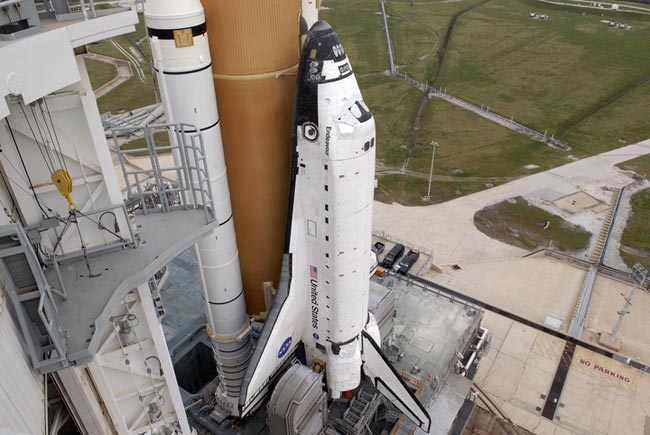Space Shuttle Gears up for Home Improvement in Orbit

CAPECANAVERAL, Fla. - When NASA?s shuttle Endeavour launches toward theInternational Space Station this Friday, it will be hauling the mother lode ofnew gear for some orbital renovations.
Set to rideup to the station aboard Endeavour are a spare space toilet, a secondkitchen, a two new bedrooms, gym equipment and a novel system to recycle urineinto fresh drinking water. Consider it a high-tech version of ?This Old House?in space.
?They?rekind of billing it here as like extreme home improvement,? Endeavour commanderChris Ferguson said in an interview. ?You can build a skyscraper, but it?s nota living building until you put in the plumbing and you put in the electricalwork. And that?s what we have the privilege of doing.?
The newgear is packed away inside Leonardo, an Italian-built cargo pod nestled inEndeavour?s payload bay, for the shuttle?s planned Friday night launch at 7:55p.m. EST (0055 Nov. 15 GMT). It?s designed to prime the space station toaccommodate double-sized, six-astronaut crews next year.
?It?s sucha large vehicle that just the maintenance of such a vehicle with athree-person crew gets to be difficult,? said Mike Suffredini, NASA?s stationprogram manager, of the outpost?s need to boost crew size.
A spacewater cycle
The stationis currently home to U.S. astronauts Michael Fincke, Greg Chamitoff and Russiancosmonaut Yury Lonchakov. But to handle the needs of three more live-inspaceflyers the station needs more water and other vital supplies.
Breaking space news, the latest updates on rocket launches, skywatching events and more!
Thecenterpiece of the new life support equipment aboard Endeavour is the waterrecovery system, which uses filters and other processes to recycle urine into apristine water supply for drinking and technical use.
Stationastronauts currently use just under a gallon of water (3.5 liters) per day,with just over half of that provided by NASA shuttle?s and cargo ships fromRussia and Europe. The remainder is recovered condensate from the interioratmosphere of the station.
With theaddition of the new waste water recovery system in action, the station wouldrequire less water deliveries from visiting spaceships for six-person crews. Ifit performs as advertised, the system could cut the annual delivery water costsfor the station by about 15,000 pounds (6,803 kg) or mass, or about 743 gallons(2,850 liters), NASA officials have said.
?It?s sortof one of those horrible and fascinating kind of things. It?s like, ?You?regoing to drink urine??? said Endeavour astronaut Sandra Magnus, who will helpinstall the system, then stay aboard to join the station?s Expedition 18 crewto fully test it. ?We?re not, we?re drinking processed water that started asurine.?
People onEarth drink processed water everyday without knowing it, she added. But theprocess is longer, starting in rivers, and running through filtration plants,faucets or toilets before being filtered once more and put back into the Earth. The steps are shorter in space.
?So theick factor is a little bit more in your face,? Magnus said. "The water that?sgoing to be coming out of this water recovery system is going to be prettyclean. Probably up to some of the highest standards that we have for water inthe United States, if not over that.?
Endeavourmission specialist Don Pettit, who served on the station?s Expedition 6 crew in2002-2003, dubbed the water recovery system a high-tech ?coffee maker.?
?It turnsyesterday?s coffee into today?s coffee and, in turn, it makes today?s coffeeinto tomorrow?s coffee,? he said in a NASA interview. ?It?s one of these great,circle of life things.?
Orbitaladditions
To supportlarger crews, the station also needs new bedrooms and - perhaps more importantly- a spare bathroom. NASA bought the new $19million toilet from Russia, which already has one space commodeaboard the station.
?Absolutelycritical to everybody?s health and well being in space is to have an operabletoilet,? Ferguson said in a NASA interview. ?So this gives us an opportunity tohave a spare there.?
Endeavouris also carrying the Advanced Resistive Exercise Device, an all-in-one gymcapable of giving astronauts more than 29 different workouts to keep theirmuscles strong during the long months living without gravity. A science rack toallow experiments to study the physics of combustible gases in weightless isalso packed away with other equipment.
The two newsleep compartments are also vital, though perhaps not spacious. They have aboutas much room inside as a large refrigerator, but are built with extra radiationshielding and hookups for computers and climate control, said Kevin Engelbert,Endeavour?s launch package manager.
The secondship?s galley sports the first-ever refrigerator that astronauts canuse to store or chill food items. To date, the station?s kitchenette hasoffered astronauts a choice between hot water and lukewarm water for drinks orfood rehydration.
?Mike?slooking forward to just putting drinks in there and just letting them cooldown,? said Magnus, referring to station commander Fincke.
- Video - Space Shuttle Bloopers
- Quiz - How Astronauts Live in Earth Orbit
- Video - Shuttle Flies Around Space Station

Tariq is the award-winning Editor-in-Chief of Space.com and joined the team in 2001. He covers human spaceflight, as well as skywatching and entertainment. He became Space.com's Editor-in-Chief in 2019. Before joining Space.com, Tariq was a staff reporter for The Los Angeles Times covering education and city beats in La Habra, Fullerton and Huntington Beach. He's a recipient of the 2022 Harry Kolcum Award for excellence in space reporting and the 2025 Space Pioneer Award from the National Space Society. He is an Eagle Scout and Space Camp alum with journalism degrees from the USC and NYU. You can find Tariq at Space.com and as the co-host to the This Week In Space podcast on the TWiT network. To see his latest project, you can follow Tariq on Twitter @tariqjmalik.
